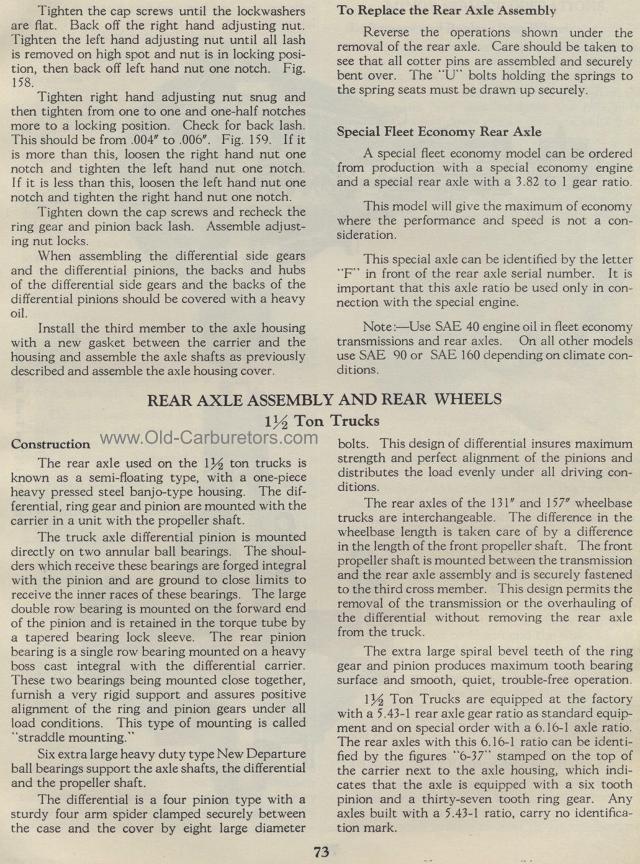Skip to: site menu | section menu | main content
Tighten right hand adjusting nut snug and then tighten from one to one and one-half notches more to a locking position. Check for back lash. This should be from .004" to .006". Fig. 159. If it is more than this, loosen the right hand nut one notch and tighten the left hand nut one notch. If it is less than this, loosen the left hand nut one notch and tighten the right hand nut one notch.
Tighten down the cap screws and recheck the ring gear and pinion
back lash. Assemble adjusting nut locks.
When assembling the differential side gears and the differential pinions, the
backs and hubs of the differential side gears and the backs of the differential
pinions should be covered with a heavy oil.
Install the third member to the axle housing with a new gasket between the carrier
and the housing and assemble the axle shafts as previously described and assemble
the axle housing cover.
To Replace the Rear Axle Assembly
Reverse the operations shown under the removal of the rear axle. Care should
be taken to see that all cotter pins are assembled and securely bent over. The "U" bolts
holding the springs to the spring seats must be drawn up securely.
Special Fleet Economy Rear Axle
A special fleet economy model can be ordered from
production with a special economy engine and a special rear axle
with a 3.82 to 1 gear ratio.
This model will give the maximum of economy where the performance
and speed is not a consideration.
This special axle can be identified by the letter "F" in
front of the rear axle serial number. It is important that this
axle ratio be used only in connection with the special engine.
Note:— Use SAE 40 engine oil in fleet economy transmissions
and rear axles. On all other models use SAE 90 or SAE 160 depending
on climate conditions.
REAR AXLE ASSEMBLY AND REAR WHEELS
1.5 Ton Trucks
bolts. This design of differential insures maximum strength and
perfect alignment of the pinions and distributes the load evenly
under all driving conditions.
The rear axles of the 131" and 157" wheelbase trucks
are interchangeable. The difference in the wheelbase length is
taken care of by a difference in the length of the front propeller
shaft. The front propeller shaft is mounted between the transmission
and the rear axle assembly and is securely fastened to the third
cross member. This design permits the removal of the transmission
or the overhauling of the differential without removing the rear
axle from the truck.
The extra large spiral bevel teeth of the ring gear and pinion
produces maximum tooth bearing surface and smooth, quiet, trouble-free
operation.
1M Ton Trucks are equipped at the factory with a 5.43-1 rear axle
gear ratio as standard equipment and on special order with a 6.16-1
axle ratio. The rear axles with this 6.16-1 ratio can be identified
by the figures "6-37" stamped on the top of the carrier
next to the axle housing, which indicates that the axle is equipped
with a six tooth pinion and a thirty-seven tooth ring gear. Any
axles built with a 5.43-1 ratio, carry no identification mark.
Construction
The rear axle used on the 1M ton trucks is known as a semi-floating
type, with a one-piece heavy pressed steel banjo-type housing.
The differential, ring gear and pinion are mounted with the carrier
in a unit with the propeller shaft.
The truck axle differential pinion is mounted directly on two annular
ball bearings. The shoulders which receive these bearings are forged
integral with the pinion and are ground to close limits to receive
the inner races of these bearings. The large double row bearing
is mounted on the forward end of the pinion and is retained in
the torque tube by a tapered bearing lock sleeve. The rear pinion
bearing is a single row bearing mounted on a heavy boss cast integral
with the differential carrier. These two bearings being mounted
close together, furnish a very rigid support and assures positive
alignment of the ring and pinion gears under all load conditions.
This type of mounting is called "straddle mounting."
Six extra large heavy duty type New Departure ball bearings support
the axle shafts, the differential and the propeller shaft.
The differential is a four pinion type with a sturdy four arm spider
clamped securely between the case and the cover by eight large
diameter
